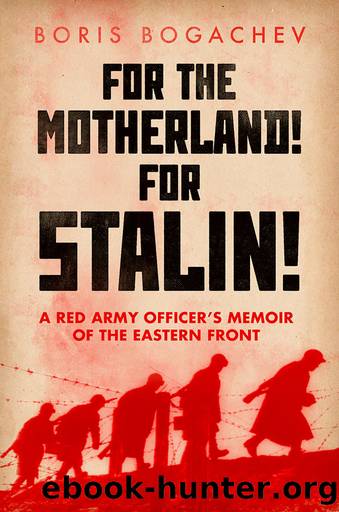For the Motherland! for Stalin! by Bogachev Boris; Bogacheva Maria; Roberts Professor Geoffrey

Author:Bogachev, Boris; Bogacheva, Maria; Roberts, Professor Geoffrey
Language: eng
Format: epub
Publisher: C. Hurst and Company (Publishers) Limited
Published: 2017-08-15T00:00:00+00:00
19
MINE-LAYING IN POLAND
NEW YEAR 1945—LAYING MINES
I saw in the New Year of 1945, in the village of Pustynia, not far from the town of Mielec. All the officers of the battalion gathered together in a hut, had a drink, became very merry and danced to the accompaniment of an accordion. Suddenly the soldier on duty rushed into the hut. ‘There’s shooting at the medical unit!’ he yelled. We grabbed our pistols and ran to the house where the medical unit was based. It turned out that two of our officers had downed quite a few drinks before going to the house to see Nurse Varya. They had a quarrel which resulted in a duel. They started shooting at each other in the dark. Fortunately all ended well and the culprits found themselves locked in a peasant’s cellar overnight.
In Moscow thirty years later, I heard people speaking Polish in a household store near Kievsky Railway Station. ‘Where are you from?’ I asked. ‘From Mielec,’ they replied. ‘Do you know Pustynia?’ ‘We certainly do,’ they answered and stared at me in amazement. They couldn’t believe that they would be reminded of a small Polish village in the great city of Moscow.
We were laying mines near this village along the front of our defences as our position was dangerously open to German tanks. As usual we were laying mines at night in the dark because this area was clearly visible to the enemy during the day. The mission was urgent and it had to be completed at all costs.
We carried out our task in the following way. A long cord with knots showing where the mines were to be laid was stretched out from the middle point of our defence, then other cords with knots were pulled out to the sides like branches. This overcame the problem of being unable to see in the dark, allowing mines to be placed in a grid as if on a chessboard. Different tasks were distributed among the sappers—some brought mines one in each hand (a mine weighs five kilos), while others bored holes in the frozen ground with pointed iron bars, pickaxes and axes. The holes were twenty centimetres deep and forty centimetres in diameter. The sergeant in command of the unit placed each mine in a hole, screwed in the explosive, then buried it and disguised it.
The frozen ground was very difficult to dig as it was hard as stone. Once I had sorted out the logistics I joined in and dug holes until my hands were bleeding. The minefield was big, about 200 metres wide. There were no rest breaks. As dawn approached we were exhausted. But no one complained. As well as laying mines, we had to mark out the area of the minefield on a local map, with reference to landmarks such as houses, trees, roads, the edge of forests and so on. That was done in daytime, but secretly.
It was almost morning and we were still out on the frontline when there was a bizarre incident.
Download
This site does not store any files on its server. We only index and link to content provided by other sites. Please contact the content providers to delete copyright contents if any and email us, we'll remove relevant links or contents immediately.
Melania and Me by Stephanie Winston Wolkoff(879)
Live in Love by Lauren Akins & Mark Dagostino(827)
The Class of 83 by Hussain Zaidi(807)
Dancing in the Mosque by Homeira Qaderi(755)
A History of My Brief Body by Billy-Ray Belcourt(741)
Just as I Am by Cicely Tyson(603)
Stranger Care by Sarah Sentilles(603)
The Schoolgirl Strangler by Katherine Kovacic(579)
Unforgetting by Roberto Lovato(575)
Broken Horses by Brandi Carlile(572)
Berlin Diary: The Journal of a Foreign Correspondent 1934-41 by William L. Shirer & Gordon A. Craig(548)
Paris Without Her: A Memoir by Gregory Curtis(545)
Harriet Tubman: The Biography by University Press(541)
Robespierre: A Revolutionary Life by Peter McPhee(535)
1914 by Luciano Canfora(534)
One Life by Megan Rapinoe & Emma Brockes(519)
Ariel (english and spanish Text) by Sylvia Plath(519)
Black Mass by Dick Lehr & Gerard O'Neill(489)
Playboy Laughs by Farmer Patty;(480)
